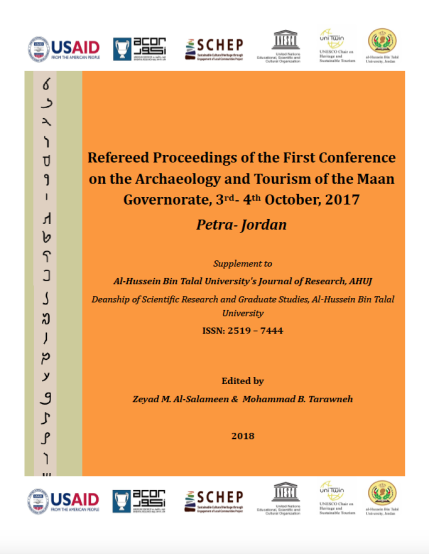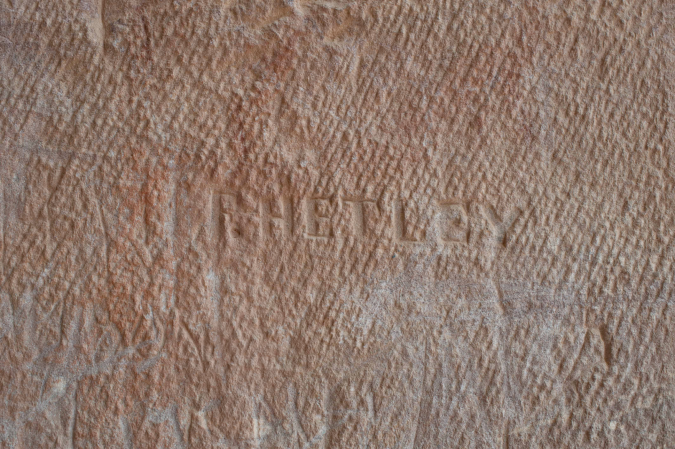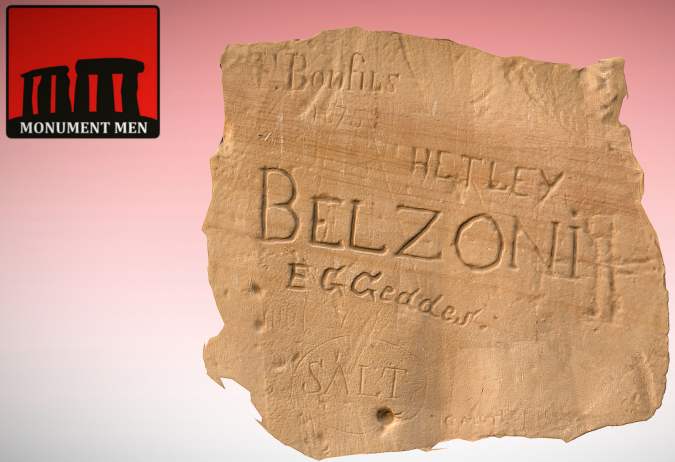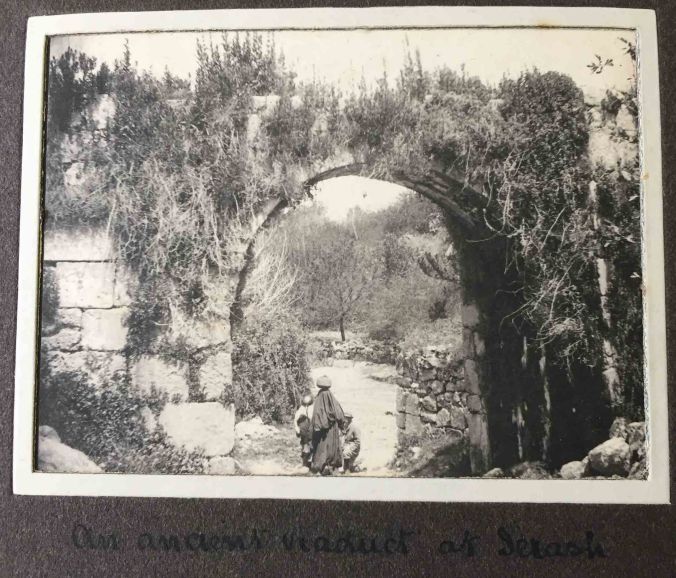The list published by Brünnow and von Domaszewski (1904: 192-4) of the names of western visitors to Petra cut into the walls of the Khazne runs to several score. Most include a date and sometimes a place of origin. Their list ends with 15 names for which there is neither date nor placename. It seems likely that once it became common to provide a date then most subsequent visitors would include one. Consequently, it is probable that names without a date are earlier rather than later.
One of the undated names was read as ‘P. Hetley’ (1904: 194). Although almost all trace of these names has now been erased in the Khazne, a recent photograph shows that Hetley’s survives and clearly reads: ‘F. HETLEY’
The name is uncommon and this is presumably the ‘F. Hetley’ recorded by Budge (1907: 478) on a wall inside the temple at Semna on the Nile in northern Sudan, also without a date. The name is linked there with another – ‘F. HETLEY & J. PAGET’ and both were evidently cut by the same hand as may also be true of ‘A. BURLINGHAM’ above them.
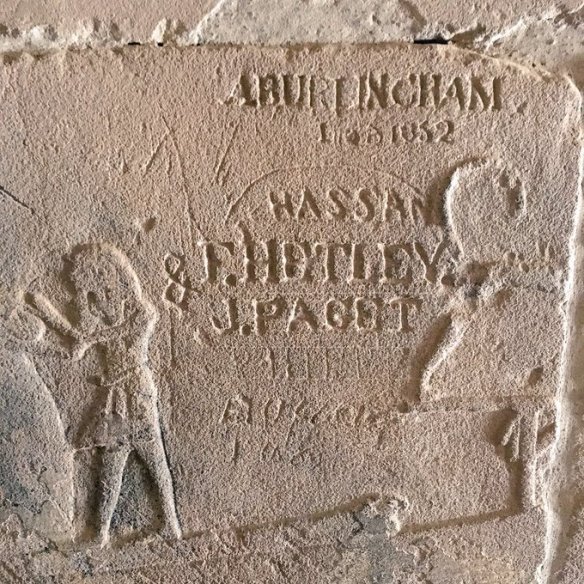
Fig. 2: Temple at Semna, Northern Sudan: Graffiti of western visitors. Now in National Museum, Khartoum (Photo: Neal Spencer)
He appears again as HETLEY (Ramesseum), F. HETLEY (Soleb) and E HETLEY (sic) (Abu Simbel, Great Temple) (Roger O. De Keersmaecker, pers comm. 10 November 2019). In none is there a date.

Fig. 4: Temple of Soleb, Northern Sudan: Graffiti of western visitors. (Photo: Roger O. De Keersmaecker)
‘F. Hetley’ (1821-1904) seems to have been Frederic Hetley M.D., elected a Fellow of the Royal College of Surgeons in 1843. He appears frequently in medical publications. Two references in the pages of non-medical journals seem to clinch his identity with the traveller in Egypt. The Literary Gazette and Journal of Science and Art (No. 1926 (Nov. 19, 1853): 1124) recorded under ‘Proceedings of Societies’:
Syro- Egyptian. —Nov. 8th.—Dr. Camps in the chair. Thomas Hayes, Esq. , Charles Parish, Esq. , and Frederick (sic) Hetley, Esq., travellers in the East, and Mrs. Alex. Kerr, translator of ‘ Ranke’s History of Servia,’ were elected members.
Then, the following year, The Journal of Sacred Literature (NS VI, 1854: 533) recorded:
At the Syro-Egyptian Society, April 11th—1. A communication was made by Frederick (sic) Hetley, Esq., regarding some stamped terra cottas found by him among the ruins of Palmyra, and specimens of which, as well as an enlarged drawing, were exhibited to the Society. The reliefs represented two personages, apparently male and female, seated on a sofa, like a Roman victinium, and both wearing head-dresses not unlike some modern Asiatic crowns. Others represented the busts of the same personages.
In short, Hetley had already before November 1853 established his credentials as a traveller in the East and on 11 April 1854 was reporting on art work obtained by him at Palmyra. We may suppose that Hetley’s journies through Egypt and to Petra, then – presumably, Palestine, then, via Damascus we may presume, to Palmyra and finally he would surely have added Baalbek on his way to Beirut, were in late 1852/ early 1853 or earlier.
Keersmaecker suggests that ‘J. Paget’ may be Arthur John Snow Paget who is reported to have “… spent the winter of 1861-62 in ascending the Nile to the second cataract; his love of knowledge, here as ever, making him plunge with avidity into all the mysteries of Egyptian lore.” (“Arthur Paget”, Gentleman’s Magazine, June 1863: 798-799). There were many travellers to Petra in 1862 but – as noted above, Hetley’s journey had been at least 9 years earlier nor is there any good reason to identify Arthur Paget with the ‘J. Paget’ paired with Hetley’s name at Semna.
Also at Semna one of the names not far from that of Hetley and Paget is: ‘A. Burlingham 1852’ (Fig. 2). In the Khazne at Petra Brünnow and von Domaszewski (1904: 193) record ‘A. Hanbury 1852’ This seems more likely to be an error for the well-known ‘B. Hanbury’ who descended the Nile in 1820-21 together with G. Waddington, both recorded in graffiti in Egypt (Fig. 3; Waddington and Hanbury 1822). Perhaps ‘A. Hanbury 1852’ should have been read as ‘B. Hanbury 1822’, a date consistent with his journey on the Nile the previous year.
The most likely date at this stage is that Frederic Hetley crossed Sinai and visited Petra in Spring 1853 or a year or two earlier. It would be useful and interesting to be able to place his trip and the man himself. A trip down the Nile to Nubia was increasingly common and not especially fraught. In contrast, the Long Desert Route to Petra, the tour of the Decapolis cities ‘east of Jordan’ and an expedition from Damascus to Palmyra were all physically hard and very challenging. As the brief reports above make clear, Frederic Hetley undertook at least two of those – a relative rarity.
[David L. Kennedy – 22/11/2019]
R. E. Brünnow and A. von Domaszewski, Die Provincia Arabia, auf grand Zweier in den Jaahren 1897 und 1898 Unternommenen Reisen und den Berichte Früherer Reisender, 3 vols. (Strassburg, 1904-1909)
Budge, E. A. (1907) The Egyptian Sudan, its History and Monuments, London
Keersmaecker, R. O. de (2016) “John Gardner Wilkinson”, ASTENE Bulletin 68: 15-20
Waddington, G. and Hanbury, B. (1822) Journal of a Visit to some Parts of Ethiopia, London

